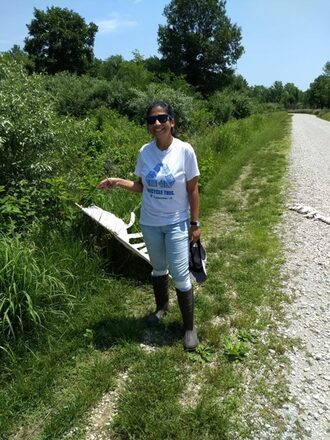A tick bite can happen anywhere: a park, your backyard, a farm field. The uncertainty can be scary. Do you pull it out? How? What do you do with the tick? What if you get sick?
A call, email, or visit to the local University of Illinois Extension office can help provide some peace of mind. New research from a multi-department team of university scientists explored the role Illinois Extension has in educating communities about ticks and preventing risky encounters.
Once uncommon in the Midwest, deer ticks, American dog ticks, lone star ticks, and others are now found across Illinois and tick-borne diseases such as Lyme disease, Rocky Mountain spotted fever, anaplasmosis, and babesiosis are on the rise. Cases of alpha-gal syndrome, a red meat allergy, have also increased. Those who spend a lot of time outdoors, either for work or recreation, have a higher risk of being bitten.
As a land-grant institution, part of the university’s mission is to share research-based information with communities through programs led by Extension educators and staff who are based in county offices and regional research centers. This puts Extension staff in a unique position to provide tick prevention education.
“Many people are used to coming to an Extension office with a question about plants or insects, and Extension is often a primary source of information about ticks in rural communities and for farmers,” said Chris Evans, forestry Extension and research specialist and participating researcher.
The project began with a survey of agriculture workers about their tick exposure and awareness. Then, the research team assessed Extension staff and volunteer knowledge and practices both before and after providing training on tick identification, diseases, and prevention.
“By assessing the perceptions of Extension staff in Illinois, we identified gaps in their knowledge and then provided continuing education on ticks that empowers them to engage confidently with their communities on this critical issue,” said Sulagna Chakraborty, a postdoctoral research associate in the department of veterinary clinical medicine at University of Illinois Urbana-Champaign and lead researcher for the project.
After taking the course, staff and volunteers knew more about tick bite prevention measures, tick identification, and diseases. They also reported being more confident in their ability to talk with the public about ticks. The course training videos are available to watch online.
Tick Bite Prevention and Care
Tick bite prevention:
- When outdoors in tall grass or wooded areas, wear light-colored long pants and long-sleeved shirts. Tuck pant legs into boots. Use an insect repellent containing DEET or picaridin on exposed skin. Spray clothes and gear with permethrin, a product that repels ticks. Inspect yourself thoroughly after time outdoors for ticks.
- Land managers can mow tall grasses, conduct controlled burns, and remove invasive species to remove tick habitats.
- Use appropriate tick repellant for pets and companion animals and check them for ticks. Livestock should also be regularly checked for ticks and consult with a veterinarian about anti-tick repellants.
If bitten by a tick:
- Use tweezers to grasp the tick close to the skin and remove it. Wash the area with disinfectant.
- Take a photo of the tick and store it in a container in the freezer.
- Contact your local Extension office for help with identification and more information.
- Follow up with a physician if symptoms of tickborne disease occur.
Find more information about ticks and tick-borne diseases on the I-TICK and Illinois Department of Public Health websites.
The study, “Assessing knowledge gaps and empowering Extension workers in Illinois with information on ticks and tickborne diseases through KAP surveys,” is published in Heliyon [DOI: 10.1016/j.heliyon.2024.e25789]. Authors include Sulagna Chakraborty, Heather Kopsco, Chris Evans, Nohra E Mateus-Pinilla, and Rebecca Lee Smith.
The research project was a collaboration between University of Illinois Extension and the Department of Pathobiology in the College of Veterinary Medicine, the Wildlife Veterinary Epidemiology Laboratory with the Illinois Natural History Survey and the Program in Ecology, Evolution & Conservation Biology in the School of Integrative Biology. The project was funded by Illinois Extension and the College of Agricultural, Consumer and Environmental Sciences, with financial support from the Office of the Provost Investment for Growth Program.
Extension collaboration grants connect campus-based researchers and field staff to work on projects that will improve the quality of life of Illinois residents in the critical areas of food, economy, environment, community, and health.
SOURCES: Sulagna Chakraborty, postdoctoral research associate, department of veterinary clinical medicine; Chris Evans, forestry Extension and research specialist.
***Courtesy of the University of Illinois Extension***
















